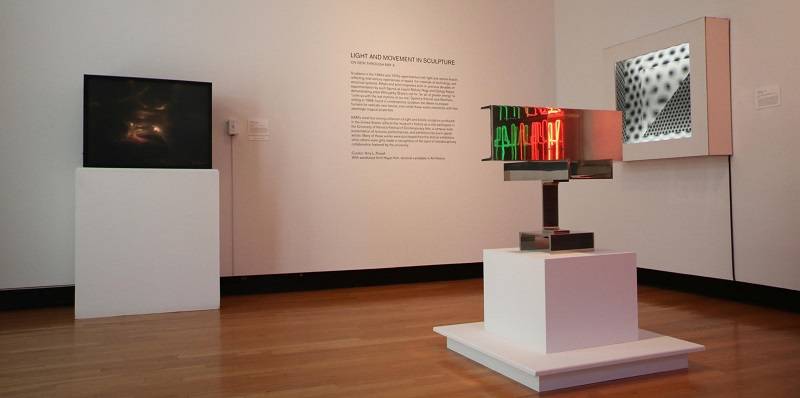This fall, I was lucky enough to see Future Present (October 2, 2016 – January 3, 2017), the first retrospective of László Moholy-Nagy’s work in nearly 50 years, at the Art Institute of Chicago. Moholy-Nagy was a major figure in the Bauhaus school, made his name as the head of the metal workshop, and was invited to start a “New Bauhaus” in Chicago (which later became the IIT Institute of Design). Fascinated by this very rudimentary bit of Illinois art history, I was thrilled to see that the Krannert Art Museum would open a Light and Movement in Sculpture exhibit from January 27-June 2, 2017.
The curator’s statement reads, “Sculptors in the 1960s and 1970s experimented with light and optical illusion, reflecting mid-century experiences of speed, the materials of technology, and structural systems. Artists and artist-engineers built on previous decades of experimentation by such figures as Laszlo Moholy-Nagy and Gyorgy Kepes, demonstrating artist Willougby Sharp’s call for “an art of greater energy” to “unite us with the real rhythms of our era.” Indeed, Moholy-Nagy’s Light Prop for an Electric Stage, which rotates to produce an array of visual effects when its moving surfaces interact with a beam of light, is considered one of the first kinetic sculptures.
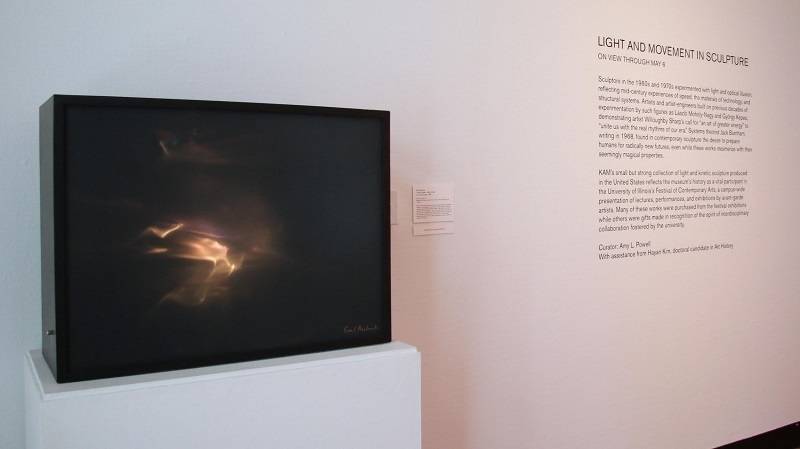
Light and Movement in Sculpture features sculptures from seven different major artists: Fletcher Benton, Max Finkelstein, Earl Reiback, Richard Hunt, Chryssa, James Prestini, and Richard Levi. Several of these sculptures were purchased for the University of Illinois’s biannual Festival of Contemporary Arts, a campus-wide presentation of lectures, performances, and exhibitions by avant-garde artists that took place from 1948-1953. Two of the artists, Richard Hunt and Fletcher Benton, are also responsible for permanent outside installations around campus – making the exhibit a scavenger hunt. And several of the artists are either from or were educated in Illinois. Though small, Light and Movement in Sculpture sits impressively at the nexus of regional history, institutional history, and the most influential design movement of the 20th century.
The first piece that caught my eye was an untitled lithograph from prolific Chicago-based sculptor Richard Hunt. Hunt grew up on Chicago’s south side in the 1930s, and was educated at the Art Institute of Chicago, where he focused on welding and lithography. The Museum of Modern Art acquired his Arachne in 1956 while he was still a student, and he went on to become the first African-American sculptor to have a major solo exhibition at the Moma in 1971. The untitled lithograph is an abstract composition in black and white with what looks like melting hoops and lines, which are spaced to create depth and movement. Many of Hunt’s sculptures convey a sense of what he has called “freedom from gravity” or “ascendancy,” like the famous Jacob’s Ladder sculpture in the Carter Woodson Regional Library in Chicago. Although the lithograph features the only organic shapes created by a human hand in the whole exhibit, it’s clear that his lines mimic the behavior of welded metal. On the other hand, his sculptures remind me of the movement of human and animal bodies.
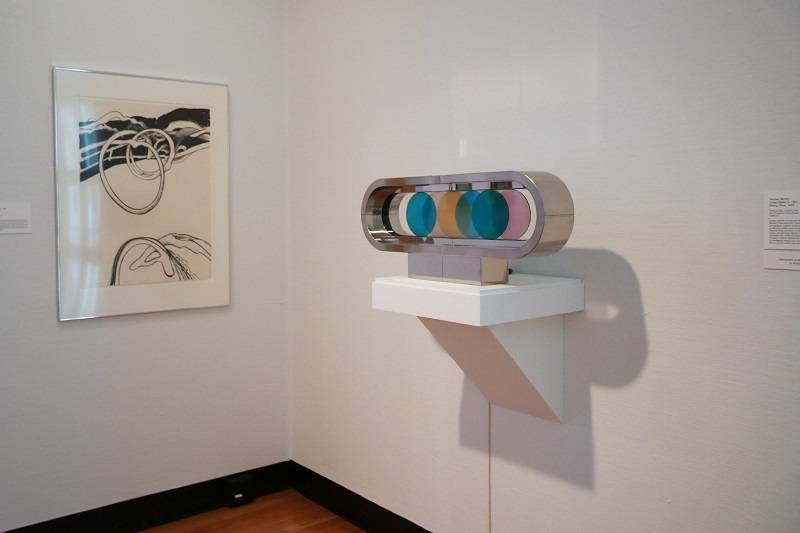
I also liked Small Study for Automat by Chryssa. Neon bars spell the word “automat,” but with the letters elongated and folded over on themselves inside a plexiglas box. Chryssa was a Greek-American artist who moved to New York City in the mid-1950s where, inspired by her surroundings, she discovered the artistic potential of neon. The lights of Times Square reminded her of the “gold of Byzantine mosaics or icons…it comes and goes in the foreground instead of remaining in the background.” She is known as a pioneer in luminist sculpture: the majority of her pieces feature neon bent into words and letters which are then layered and fragmented to obscure meaning. I went to the Neon Museum in Las Vegas a few years ago, and I connected the strange experience of walking around in a graveyard of larger-than-life signs with Chryssa’s linking of glowing signage to mythology and iconography. The title “small study” suggests correctly that many of Chryssa’s sculptures are humungous (you can actually walk through her The Gates to Times Square).
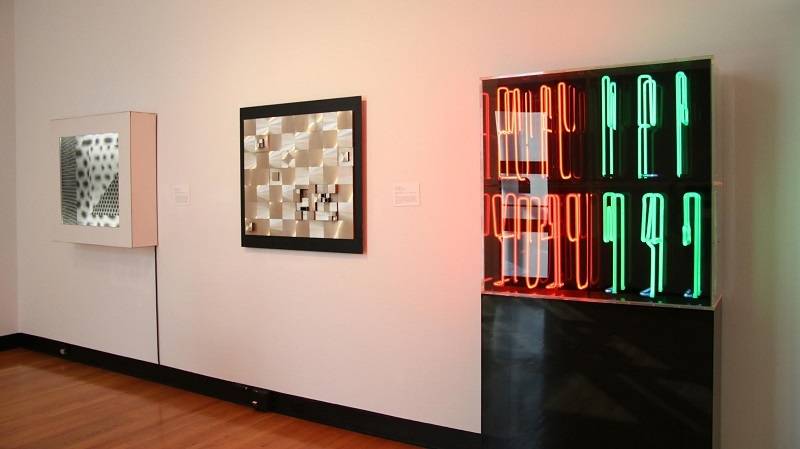
Last but not least, I enjoyed learning about James Prestini, who after studying mechanical engineering at Yale, taught the foundational course at the Institute of Design with Moholy-Nagy. He is best known for his pristine lathe-turned bowls, but he turned to steel later in his career, claiming that “A humane art of the future must incorporate the technologies of the future.” His piece, Construction #216, is made of reflective steel bars balanced on top of one another. Construction #216 was not my favorite, but his bowls evidence a pretty incredible commitment to craft. After his tenure at the Institute of Design, he taught design at UC Berkeley for many years. The teaching model used in many design classrooms today, where students design objects in response to a “design problem,” has its origins in the Bauhaus movement, and at the Chicago History Museum you can see small-scale models of objects designed by students in Moholy-Nagy and Prestini’s classes.
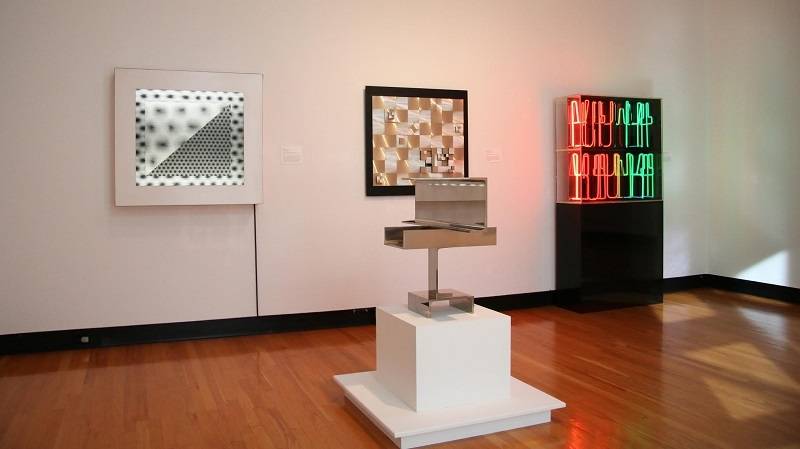
Even if you don’t automatically connect with lightboxes and steel beams, I recommend seeing Light and Movement in Sculpture for the historical connections, and because some of the more technical sculptures are just downright cool. The Krannert has even provided a handy dandy library guide if you want to learn more about any of the artists or the history of kinetic or luminist sculpture.
Krannert Art Museum is located at the corner of Sixth and Peabody in Urbana. The Light and Sculpture exhibition will remain on display through June 2nd, 2017.
Light and Movement in Sculpture, installation view at Krannert Art Museum, 2017. All images courtesy of Krannert Art Museum, University of Illinois at Urbana-Champaign.








